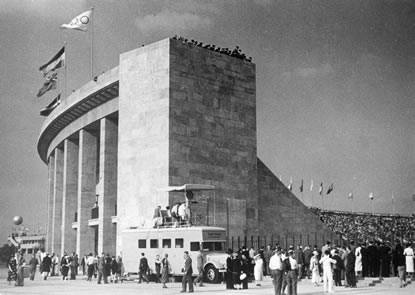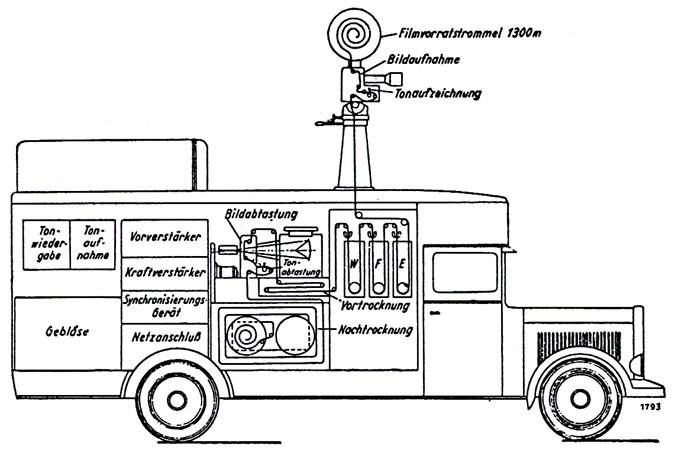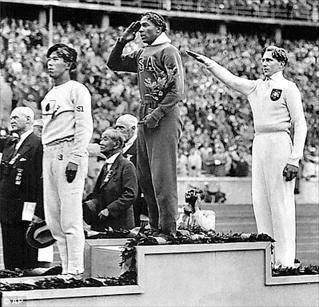

Amazing New Berlin Olympics Television Information
If you are lucky, you learn something new every day, and today, we are all lucky! I had no idea that what you are about to read and see here ever happened, but thanks to yesterday’s post on the first mobile units, we have fascinating new images and video to share.
Thanks to David Breneman and James Freeman, we now know that there was indeed a mobile unit in service at the 1936 Berlin Olympics…BUT…not in the classic sense, of being equipped with live electronic video cameras shooting the action.
Instead, the German unit was an “intermediate film” television apparatus, which I had never heard of either.
It works this way…a normal cinema camera, mounted on a transport van, initially records the footage on film, which is sent down the camera’s light tight pedestal into the van. There, the film is immediately developed inside the van and then run through a flying spot scanner camera (so called because it moved a focused beam of light back and forth across the image), and electronically converted from a negative to a positive television image. Scenes from the just developed film could be broadcast with a delay of about a minute.
In this video, you can see the Telefunken cameras and the Berlin van, with an animated diagram of how it works. The photos include a shot of the van, a diagram of the operation, US champion Jessie Owen and a Telefunken Canon camera, and at the end a few seconds of film shot by the van top camera.
John Logie Baird began developing the process in 1932, borrowing the idea of Georg Oskar Schubert from his licensees in Germany, where it was demonstrated by Fernseh AG in 1932 and used for broadcasting in 1934.
The BBC used Baird’s version of the process during the first three months of its then-“high-definition” television service from November 1936 through January 1937, and German television used it during broadcasts of the 1936 Summer Olympics. In both cases, intermediate film cameras alternated with newly introduced direct television cameras.
The intermediate film system, with its expensive film usage and relatively immobile cameras, did have the advantage that it left a filmed record of the program which could be rerun at a different time, with a better image quality than the later kinescope films, which were shot from a video monitor.
Television tubes developed by Farnsworth and Zworykin in the United States, and by EMI in England, with much higher sensitivity to light, made the intermediate film system obsolete by 1937.
I had no idea that motion picture film could be developed that fast, which brings up all kind of questions about NBC’s mad dashes to get kinescope film turned around for rebroadcast on the west coast.
Now…back to Berlin. In addition to the mobile unit camera, three state-of-the-art Iconoscope cameras are also used, among them Telefunken’s ‘Olympic Cannon’, which earns its nickname due to the large lens. There was also a single Fernseh experimental camera there using the Farnsworth Image Dissector tube.
There was a built in control room in the stadium, which fed the coverage to two special lines that went directly to the Berlin TV tower for broadcast. Therefore, there was no need for an electronic television remote unit, in the classic sense.
These cameras broadcast eight hours of moving images per day. There are 75 television sets in Berlin, most of them in the 27 public television parlors. There are two other parlous in Potsdam and Leipzig. At the time, the television broadcasts are sensational events for the audience. But they are barely comparable with today’s public viewing: the screens on the television sets are barely larger than a modern tablet PC display. Thanks for all the help in bringing interesting new information to light! -Bobby Ellerbee



I think this thread has drawn together more information in one place about television technology in the 1936 Olympics than any other… (to borrow an Olympics term) …Venue.
My late aunt took part and gained a bronze medal in high jump.
Unfortunately, a lot of the “television parlors” (small theaters) around Berlin, where people could come in off the street and view the games, used mirror-screw projectors. The inertia of the mirror assembly prevented it from complying with minor timebase fluctuations in the signal, resulting in flagging of the picture, sometimes objectionably. Those who viewed the events on CRT receivers had a much better viewing experience.
a part of the “Olympic Canon” lens still exists, saw it this summer in Berlin.
The Baird system was shown on a recent BBC 4 documentary “Television’s Opening Night”. https://youtu.be/kfoerQyiTHY